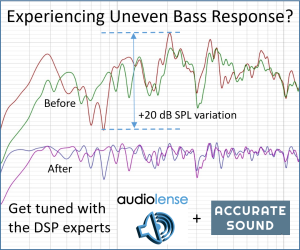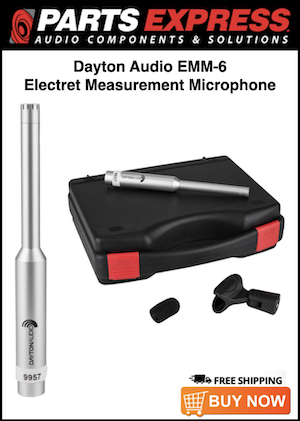-
AUDIO VIDEO PROCESSING, SETUP & ENVIRONMENTOfficial REW (Room EQ Wizard) Support Forum Audiolense User Forum Calibration Equipment Auto-EQ Platforms / Immersive Audio Codecs Video Display Technologies / Calibration AV System Setup and Support Listening Room / Home Theater Build Projects Room Acoustics and Treatments AV Showcase Movies / Music / TV / Streaming
-
AUDIO VIDEO DISCUSSION / EQUIPMENTHome Theater / Audio and Video - Misc Topics Essence For Hi Res Audio AV Equipment Advice and Pricing Awesome Deals and Budget AV Equipment AV Receivers / Processors / Amps UHD / Blu-ray / CD Players / Streaming Devices Two Channel Hi-Fi Equipment DIY Audio Projects Computer Systems - HTPC / Gaming HD and UHD Flat Screen Displays Projectors and Projection Screens AV Accessories Buy - Sell - Trade
Navigation
Install the app
How to install the app on iOS
Follow along with the video below to see how to install our site as a web app on your home screen.
Note: This feature may not be available in some browsers.
More options
You are using an out of date browser. It may not display this or other websites correctly.
You should upgrade or use an alternative browser.
You should upgrade or use an alternative browser.
Room EQ Comparison
- Thread starter Eric SVL
- Start date
AustinJerry
Member
- Joined
- Jun 5, 2017
- Posts
- 226
If I have Audy XT32, is it worth it to upgrade my AVR just to get Anthem ARC?
I don't know, not being familiar with ARC. But I can definitely say that upgrading to a processor that supports Dirac Live with Dirac Bass Control will definitely get you a better sounding room correction.
Eric SVL
Member
Thread Starter
- Joined
- May 1, 2017
- Posts
- 173
More
- Preamp, Processor or Receiver
- Denon AVR-X4500H
- Main Amp
- Hypex NCore NC252MP
- DAC
- Micca OriGen G2
- Computer Audio
- iLoud MTM
- Universal / Blu-ray / CD Player
- Sony PS3, PS4
- Streaming Equipment
- Google Chromecast
- Streaming Subscriptions
- GIK Tri-Traps
- Front Speakers
- Buchardt S400
- Surround Speakers
- Polk LSiM 702
- Front Height Speakers
- Focal Chorus OD 706 V
- Rear Height Speakers
- Focal Chorus OD 706 V
- Subwoofers
- Rythmik
- Other Speakers
- ELAC Debut Reference DFR52
- Screen
- Samsung PN64H5000
I have no experience with ARC, but it would have to have something like Dynamic EQ for me to consider switching to another room EQ system.If I have Audy XT32, is it worth it to upgrade my AVR just to get Anthem ARC?
CHFels
New Member
- Joined
- Aug 11, 2019
- Posts
- 7
More
- Preamp, Processor or Receiver
- Arcam SR250
- Universal / Blu-ray / CD Player
- Marantz UD7007
- Front Speakers
- Spendor Classic 3/1
I have no experience with ARC, but it would have to have something like Dynamic EQ for me to consider switching to another room EQ system.
As this post goes to show, it all depends on how you use Audyssey and how happy you are with the results. If you have Dynamic EQ switched on at all times and don't like the sound without it, then probably neither ARC nor Dirac will make you happy (or at least, it would take you a while to adjust). On the other hand if you sometimes listen to music without Audyssey engaged at all, and value audiophile things like pinpoint imaging, soundstage depth, vocal purity and so on, then maybe you would be happier with an Anthem or Lyngdorf or Arcam or NAD. In addition to the superior room correction, all of these tend to be better-sounding amps in the first place than anything from Denon or Marantz that sports XT32.
Eric SVL
Member
Thread Starter
- Joined
- May 1, 2017
- Posts
- 173
More
- Preamp, Processor or Receiver
- Denon AVR-X4500H
- Main Amp
- Hypex NCore NC252MP
- DAC
- Micca OriGen G2
- Computer Audio
- iLoud MTM
- Universal / Blu-ray / CD Player
- Sony PS3, PS4
- Streaming Equipment
- Google Chromecast
- Streaming Subscriptions
- GIK Tri-Traps
- Front Speakers
- Buchardt S400
- Surround Speakers
- Polk LSiM 702
- Front Height Speakers
- Focal Chorus OD 706 V
- Rear Height Speakers
- Focal Chorus OD 706 V
- Subwoofers
- Rythmik
- Other Speakers
- ELAC Debut Reference DFR52
- Screen
- Samsung PN64H5000
I do value "audiophile" things like pinpoint imaging, soundstage depth, vocal purity and so on and Audyssey has no direct effect on them other than via its adjustments to frequency response. The much better bass and slightly accentuated treble of Dynamic EQ, based on volume level, serves to enhance these things in the 5 systems I have used it with so far. There have been no downsides or I wouldn't use it.As this post goes to show, it all depends on how you use Audyssey and how happy you are with the results. If you have Dynamic EQ switched on at all times and don't like the sound without it, then probably neither ARC nor Dirac will make you happy (or at least, it would take you a while to adjust). On the other hand if you sometimes listen to music without Audyssey engaged at all, and value audiophile things like pinpoint imaging, soundstage depth, vocal purity and so on, then maybe you would be happier with an Anthem or Lyngdorf or Arcam or NAD. In addition to the superior room correction, all of these tend to be better-sounding amps in the first place than anything from Denon or Marantz that sports XT32.
As far as "better sounding amps" than Denon, you wouldn't be able to make that claim after a blind test.
AustinJerry
Member
- Joined
- Jun 5, 2017
- Posts
- 226
As this post goes to show, it all depends on how you use Audyssey and how happy you are with the results. If you have Dynamic EQ switched on at all times and don't like the sound without it, then probably neither ARC nor Dirac will make you happy (or at least, it would take you a while to adjust). On the other hand if you sometimes listen to music without Audyssey engaged at all, and value audiophile things like pinpoint imaging, soundstage depth, vocal purity and so on, then maybe you would be happier with an Anthem or Lyngdorf or Arcam or NAD. In addition to the superior room correction, all of these tend to be better-sounding amps in the first place than anything from Denon or Marantz that sports XT32.
I was a long-time Audyssey user, so I am very familiar with how DEQ sounds. However, other than the Reference Level Offset, there is little user control. With Dirac Live, there is a powerful capability in the use of custom target curves to tailor the entire frequency range to the listener's liking. And the typical processor that supports Dirac Live has several memory slots in which calibrations with different custom targets can be stored, and then called up with a simple button press on the remote. This allows setting the response curve to suit varying source types, say music vs. movies. The custom target curve capability alone sets Dirac Live apart from Audyssey as my room correction of choice.
Eric SVL
Member
Thread Starter
- Joined
- May 1, 2017
- Posts
- 173
More
- Preamp, Processor or Receiver
- Denon AVR-X4500H
- Main Amp
- Hypex NCore NC252MP
- DAC
- Micca OriGen G2
- Computer Audio
- iLoud MTM
- Universal / Blu-ray / CD Player
- Sony PS3, PS4
- Streaming Equipment
- Google Chromecast
- Streaming Subscriptions
- GIK Tri-Traps
- Front Speakers
- Buchardt S400
- Surround Speakers
- Polk LSiM 702
- Front Height Speakers
- Focal Chorus OD 706 V
- Rear Height Speakers
- Focal Chorus OD 706 V
- Subwoofers
- Rythmik
- Other Speakers
- ELAC Debut Reference DFR52
- Screen
- Samsung PN64H5000
Audyssey has a curve editor and an unlimited number of curves and speaker configurations you can save.I was a long-time Audyssey user, so I am very familiar with how DEQ sounds. However, other than the Reference Level Offset, there is little user control. With Dirac Live, there is a powerful capability in the use of custom target curves to tailor the entire frequency range to the listener's liking. And the typical processor that supports Dirac Live has several memory slots in which calibrations with different custom targets can be stored, and then called up with a simple button press on the remote. This allows setting the response curve to suit varying source types, say music vs. movies. The custom target curve capability alone sets Dirac Live apart from Audyssey as my room correction of choice.
AustinJerry
Member
- Joined
- Jun 5, 2017
- Posts
- 226
Audyssey has a curve editor and an unlimited number of curves and speaker configurations you can save.
True. My experience with Audyssey was before the Audyssey app was released, and my only Audyssey-capable processor is the 8802a, which does not support the new app. So to be fair, Audyssey may rival the capabilities of Dirac Live now.
Travis Ballstadt
Administrator
More
- Preamp, Processor or Receiver
- Anthem AVM60
- Main Amp
- Emotiva BasX 5
- Additional Amp
- Emotiva UPA-500
- Universal / Blu-ray / CD Player
- Kaleidescape Strato C/Terra 48TB/Compact Terra 6TB
- Streaming Equipment
- PLEX Server, AppleTV4K, Bluesound Node2i
- Streaming Subscriptions
- AppleTV+, Amazon Prime, HBO Max
- Front Speakers
- NextLevel Acoustics Reference Cinema
- Center Channel Speaker
- NextLevel Acoustics Reference Cinema
- Surround Speakers
- NextLevel Acoustics Reference Cinema
- Front Height Speakers
- NextLevel Acoustics Angled Satellite
- Rear Height Speakers
- NextLevel Acoustics Angled Satellite
- Subwoofers
- SVS SB2000 x2
- Screen
- SeymourAV Proscenium 124” diagonal 2.40:1
- Video Display Device
- JVC DLA X790R, Lumagen Radiance Pro 4240
- Remote Control
- Unfolded Circle Remote 2, powered by HomeAssistant
- Satellite System
- They still have those?
- Other Equipment
- Rega Planar 6, Rega Exact2 cart, Rega Aria Mk3 Phono Stage, Jolida JD202BRC, Rega RS-5 Speakers (2-channel system)
Audessy has definitely improved over the past couple years, but Dirac and ARC are big steps above it, in my opinion. I prefer ARC to Dirac, having gone from a Dirac processor to an ARC processor. ARC took me instantly (literally the first run out of the box) to the equivalent of 2 1/2 years of Dirac fiddling, and was very customizable from that point.
These are just opinions, though. Everyone’s will be different based on all the variables, and the fact that audio quality is objective.
There is no room correction more effective and accurate than room treatment.
These are just opinions, though. Everyone’s will be different based on all the variables, and the fact that audio quality is objective.
There is no room correction more effective and accurate than room treatment.
CHFels
New Member
- Joined
- Aug 11, 2019
- Posts
- 7
More
- Preamp, Processor or Receiver
- Arcam SR250
- Universal / Blu-ray / CD Player
- Marantz UD7007
- Front Speakers
- Spendor Classic 3/1
I do value "audiophile" things like pinpoint imaging, soundstage depth, vocal purity and so on and Audyssey has no direct effect on them other than via its adjustments to frequency response. The much better bass and slightly accentuated treble of Dynamic EQ, based on volume level, serves to enhance these things in the 5 systems I have used it with so far. There have been no downsides or I wouldn't use it.
As far as "better sounding amps" than Denon, you wouldn't be able to make that claim after a blind test.
From what you say, Eric, it sounds like you will be happy sticking with XT32. If it ain't broke, ...
Sonnie Parker
Senior Admin
More
- Preamp, Processor or Receiver
- StormAudio ISP Elite 24 MK3 Processor
- Main Amp
- McIntosh MC1.25KW Monoblock Amps
- Additional Amp
- StormAudio PA 16 MK3
- Other Amp
- McIntosh MA252 2-Channel Hybrid Integrated Amp
- Music Server
- ROON Nucleus One
- Universal / Blu-ray / CD Player
- Magnetar UDP800 UHD Player
- Streaming Equipment
- Kaleidescape Strato C Media Player
Kaleidescape Terra Prime 22TB Server
Lenovo X1 Carbon
Apple TV 4K
- Turntable/Cartridge
- Music Hall Stealth Turntable
Ortofon 2M Blue Cartridge
- Streaming Subscriptions
- Lifetime Roon Subscription
Tidal
qobuz
Netflix
Amazon Prime
- Other Equipment
- MediaLight Mk2 v2 Flex Bias Lighting
Zero Surge 8R15W-1
Zero Surge 2R20W
- Front Speakers
- RTJ 410
- Front Wide Speakers
- JTR Noesis 110HT
- Center Channel Speaker
- MartinLogan Focus C-18
- Surround Speakers
- JTR Noesis 210RT
- Surround Back Speakers
- JTR Noesis 210RT
- Front Height Speakers
- JTR Noesis 110HT-SL
- Middle Height Speakers
- JTR Noesis 110HT-SL
- Rear Height Speakers
- JTR Noesis 110HT-SL
- Subwoofers
- JTR Captivator - 4000ULF-TL x2 + 2400 x6
- Bass Shaker System
- Dayton Audio BSA-200 Amp
4 BST-1 Bass Shakers
- Other Speakers
- Wharfedale Super Linton
- Video Display Device
- Sony 98X90L
- Remote Control
- URC MX-890
- Cables
- AudioQuest - Various
THX PixelGen HDMI
Pangea Power Cables
Blue Jeans Cables
SVS Soundpath Cables
Custom Cables
- Satellite System
- Dish Joey 4K
- Other Equipment
- Salamander Synergy Equipment Stand
VTI Amp Stands for the Monoblocks
Solidsteel - S3 Series Amp Stand
- Network/Internet
- C-Spire 1Gig Fiber
Omada OC300 Controller
Omada ER8411 10G Router
Omada SG3218XP-M2 10G/2.5G Managed Switch
Omada SG2210XMP-M2 10G/2.5G Managed Switch
SilentPower LAN iPurifier Pro (for Nucleus One)
Asustor Flashstor NAS
- Headphones/IEMs
- HIFIMAN HE1000se
Unique Melody Mest MKII
- Headphone DAC/Amp
- Eversolo DMP-A6
RME ADI-2 DAC FS
HIFIMAN Goldenwave Serenade
- Whole House System
- HEOS System
Home-150 Speaker x6
Samsung S9 Tablet w/ HEOS
- Office/Study System
- Office System
Dell Precision Computer
Roon Networked
Vanatoo Transparent One Encore Plus Speakers
- Secondary/Additional Room System
- AV Test Room System
NAD M33 Streaming DAC Amp
MartinLogan Motion XT F200
JTR Captivator RS1
miniDSP EARS
Zero Surge 8R15W-1
Zero Surge 2R20W
Dell Optiplex
Roon Networked
- Additional Room System
- Sunroom System
Denon AVR-X1800H HEOS Roon Ready Receiver
Zu Audio DW-6 Speakers
Dayton Audio IO8XTW Outdoor Speakers
Roon Networked
Dish Joey
JVC 37" TV
- Additional Room System
- Cabin System
Onkyo TX-SR805 Receiver
Infinity Primus P163 Speakers
RSL Outsiders Outdoor Speakers
Shield TV Pro
Sony 55" TV
- Additional Room System
- Vinyl Room
Accuphase E-280 Integrated Amp
Technics SL-1210GR2 Turntable
Ortofon 2M Blue Cartridge
KLH Model Three Speakers
Zero Surge 8R15W-1
- Additional Room System
- Barn Jam
Denon AVR-X1600H HEOS Roon Ready Receiver
Soundfield Custom Speakers
To clarify... in most cases audiophile things like pinpoint imaging, sound stage and depth acuity should be improved with Audyssey, Dirac Live, ARC, Audiolense, etc... unless you have something an extremely high percentage of the audiophiles in the world don't have, which is the perfect room with perfectly placed speakers. Despite having a very symmetrical room and symmetrically placed speakers, during our speaker evaluations, all of these characteristics improved when we engaged Dirac Live, and every participant was able to identify and preferred the improvement in sound.
With most rooms, the frequency mismatch from one speaker to the other is sufficient enough to tarnish these characteristics to at least some affect. The recording engineer typically has frequency matched speakers when he/she creates the music, so to hear what was intended to be heard, our speakers need to be frequency matched as well, which is where the various equalization systems will help. It's not easy to get there without them, which is why we are seeing more and more audiophiles in the elite high-end groups start to prefer and use these systems.
With most rooms, the frequency mismatch from one speaker to the other is sufficient enough to tarnish these characteristics to at least some affect. The recording engineer typically has frequency matched speakers when he/she creates the music, so to hear what was intended to be heard, our speakers need to be frequency matched as well, which is where the various equalization systems will help. It's not easy to get there without them, which is why we are seeing more and more audiophiles in the elite high-end groups start to prefer and use these systems.
Eric SVL
Member
Thread Starter
- Joined
- May 1, 2017
- Posts
- 173
More
- Preamp, Processor or Receiver
- Denon AVR-X4500H
- Main Amp
- Hypex NCore NC252MP
- DAC
- Micca OriGen G2
- Computer Audio
- iLoud MTM
- Universal / Blu-ray / CD Player
- Sony PS3, PS4
- Streaming Equipment
- Google Chromecast
- Streaming Subscriptions
- GIK Tri-Traps
- Front Speakers
- Buchardt S400
- Surround Speakers
- Polk LSiM 702
- Front Height Speakers
- Focal Chorus OD 706 V
- Rear Height Speakers
- Focal Chorus OD 706 V
- Subwoofers
- Rythmik
- Other Speakers
- ELAC Debut Reference DFR52
- Screen
- Samsung PN64H5000
I do agree that you need proper speaker setup to get good imaging, but with quality speakers sample variation is small enough to not affect imaging. Sure, you could get a lemon, but I think you'd hear that anyway in the frequency response. If you get a pair of speakers that measure so differently that it messes up your tonal balance and thus imaging, you need to send them back for replacement.
With most speakers I limit my equalization to the room transition frequency and below, or sometimes slightly higher than that. It is especially true in this case that soundstage will be improved because all rooms will benefit as there is no "perfect room" for bass aside from no room at all.
With most speakers I limit my equalization to the room transition frequency and below, or sometimes slightly higher than that. It is especially true in this case that soundstage will be improved because all rooms will benefit as there is no "perfect room" for bass aside from no room at all.
Last edited:
Eric SVL
Member
Thread Starter
- Joined
- May 1, 2017
- Posts
- 173
More
- Preamp, Processor or Receiver
- Denon AVR-X4500H
- Main Amp
- Hypex NCore NC252MP
- DAC
- Micca OriGen G2
- Computer Audio
- iLoud MTM
- Universal / Blu-ray / CD Player
- Sony PS3, PS4
- Streaming Equipment
- Google Chromecast
- Streaming Subscriptions
- GIK Tri-Traps
- Front Speakers
- Buchardt S400
- Surround Speakers
- Polk LSiM 702
- Front Height Speakers
- Focal Chorus OD 706 V
- Rear Height Speakers
- Focal Chorus OD 706 V
- Subwoofers
- Rythmik
- Other Speakers
- ELAC Debut Reference DFR52
- Screen
- Samsung PN64H5000
My experience with Dirac was that it was very powerful in shaping a speaker's response, but what you say about fiddling is very true. I could never get my sub bass "right" with Dirac V2, whereas XT32 + Dynamic EQ gets it right nearly every time without any fiddling. They really perfected what the slope should be at various volume levels. It's funny because that's 10-year old tech now. And Dirac still does not have an affordable multi-sub equalization scheme. We will see if Pioneer or Onkyo can change that, but all of their electronics that feature Dirac will get more expensive than current offerings.Audessy has definitely improved over the past couple years, but Dirac and ARC are big steps above it, in my opinion. I prefer ARC to Dirac, having gone from a Dirac processor to an ARC processor. ARC took me instantly (literally the first run out of the box) to the equivalent of 2 1/2 years of Dirac fiddling, and was very customizable from that point.
However, I no longer have my Dirac AVR so I won't be able to do a direct comparison.
This statement I can't 100% agree with. Most of what I use room EQ for can't be achieved by room treatment. The treatments I would use are to help refine the setup further.There is no room correction more effective and accurate than room treatment.
AJ Soundfield
Active Member
More
- Preamp, Processor or Receiver
- Yamaha RXA800, Denon AVR-X4500, Lexicon MC10
- Main Amp
- Hypex Ncores
- Additional Amp
- Abacus Ampino, Triode Corp TRV-35SE
- DAC
- NAD M51
- Computer Audio
- AudioEngine D2
- Universal / Blu-ray / CD Player
- Yamaha BDA1010
- Front Speakers
- Soundfields
- Center Channel Speaker
- Soundfields, KEF Q150
- Surround Speakers
- Soundfields
- Surround Back Speakers
- Revel M16
- Subwoofers
- Soundfield Cardioid Rythmik Servo
- Other Speakers
- AVA ABX
To quote Dr Olive from his oft cited (but never understood, by proponents/peddlers of elixirs) scientific/non-conjecture study of some magic EQ products:With most speakers I limit my equalization to the room transition frequency and below
And of course, still free An enticing marketing storyDr. Sean Olive November 4, 2009 at 9:21 AM
Room correction will improve poor loudspeakers like the ones you have indicated, but why put an expensive bandaid on a scab if you can easily avoid getting the scab in the first place?
Won't even bother with the iso-ward room treatments thing, a lost cause.
cheers
simplex
Member
More
- Preamp, Processor or Receiver
- Rotel RC-1570
- Main Amp
- Quad 303 mod.
- Computer Audio
- Daphile @x86-Mini-PC with BruteFIR filters applied
- Universal / Blu-ray / CD Player
- Yamaha BD-A1020 (mostly inactive, Daphile rules!)
- Streaming Equipment
- audio cables custom made by myself
- Front Speakers
- Tannoy D500 mod.
- Other Equipment
- Steinberg UR12, Behringer ECM8000
Sonnie Parker
Senior Admin
More
- Preamp, Processor or Receiver
- StormAudio ISP Elite 24 MK3 Processor
- Main Amp
- McIntosh MC1.25KW Monoblock Amps
- Additional Amp
- StormAudio PA 16 MK3
- Other Amp
- McIntosh MA252 2-Channel Hybrid Integrated Amp
- Music Server
- ROON Nucleus One
- Universal / Blu-ray / CD Player
- Magnetar UDP800 UHD Player
- Streaming Equipment
- Kaleidescape Strato C Media Player
Kaleidescape Terra Prime 22TB Server
Lenovo X1 Carbon
Apple TV 4K
- Turntable/Cartridge
- Music Hall Stealth Turntable
Ortofon 2M Blue Cartridge
- Streaming Subscriptions
- Lifetime Roon Subscription
Tidal
qobuz
Netflix
Amazon Prime
- Other Equipment
- MediaLight Mk2 v2 Flex Bias Lighting
Zero Surge 8R15W-1
Zero Surge 2R20W
- Front Speakers
- RTJ 410
- Front Wide Speakers
- JTR Noesis 110HT
- Center Channel Speaker
- MartinLogan Focus C-18
- Surround Speakers
- JTR Noesis 210RT
- Surround Back Speakers
- JTR Noesis 210RT
- Front Height Speakers
- JTR Noesis 110HT-SL
- Middle Height Speakers
- JTR Noesis 110HT-SL
- Rear Height Speakers
- JTR Noesis 110HT-SL
- Subwoofers
- JTR Captivator - 4000ULF-TL x2 + 2400 x6
- Bass Shaker System
- Dayton Audio BSA-200 Amp
4 BST-1 Bass Shakers
- Other Speakers
- Wharfedale Super Linton
- Video Display Device
- Sony 98X90L
- Remote Control
- URC MX-890
- Cables
- AudioQuest - Various
THX PixelGen HDMI
Pangea Power Cables
Blue Jeans Cables
SVS Soundpath Cables
Custom Cables
- Satellite System
- Dish Joey 4K
- Other Equipment
- Salamander Synergy Equipment Stand
VTI Amp Stands for the Monoblocks
Solidsteel - S3 Series Amp Stand
- Network/Internet
- C-Spire 1Gig Fiber
Omada OC300 Controller
Omada ER8411 10G Router
Omada SG3218XP-M2 10G/2.5G Managed Switch
Omada SG2210XMP-M2 10G/2.5G Managed Switch
SilentPower LAN iPurifier Pro (for Nucleus One)
Asustor Flashstor NAS
- Headphones/IEMs
- HIFIMAN HE1000se
Unique Melody Mest MKII
- Headphone DAC/Amp
- Eversolo DMP-A6
RME ADI-2 DAC FS
HIFIMAN Goldenwave Serenade
- Whole House System
- HEOS System
Home-150 Speaker x6
Samsung S9 Tablet w/ HEOS
- Office/Study System
- Office System
Dell Precision Computer
Roon Networked
Vanatoo Transparent One Encore Plus Speakers
- Secondary/Additional Room System
- AV Test Room System
NAD M33 Streaming DAC Amp
MartinLogan Motion XT F200
JTR Captivator RS1
miniDSP EARS
Zero Surge 8R15W-1
Zero Surge 2R20W
Dell Optiplex
Roon Networked
- Additional Room System
- Sunroom System
Denon AVR-X1800H HEOS Roon Ready Receiver
Zu Audio DW-6 Speakers
Dayton Audio IO8XTW Outdoor Speakers
Roon Networked
Dish Joey
JVC 37" TV
- Additional Room System
- Cabin System
Onkyo TX-SR805 Receiver
Infinity Primus P163 Speakers
RSL Outsiders Outdoor Speakers
Shield TV Pro
Sony 55" TV
- Additional Room System
- Vinyl Room
Accuphase E-280 Integrated Amp
Technics SL-1210GR2 Turntable
Ortofon 2M Blue Cartridge
KLH Model Three Speakers
Zero Surge 8R15W-1
- Additional Room System
- Barn Jam
Denon AVR-X1600H HEOS Roon Ready Receiver
Soundfield Custom Speakers
It's not the speaker that I would be most concerned with... it's the interaction of the speaker with the room that typically makes them out of frequency balance. As alluded to, most folks don't have the perfect room, and asymmetrically placed speakers along with asymmetrical rooms will cause the speakers to be quite different in their frequency response. Seen this about fifty-eleven times when I was in tech support with SVS and customers were placing their speakers in living rooms, great rooms, bedrooms, etc... rarely did the frequency response between speakers match due to room interaction. Those that had symmetrical theater rooms (like mine) didn't usually have any issues, other than poor response for both speakers that sounded much improved after equalization.I do agree that you need proper speaker setup to get good imaging, but with quality speakers sample variation is small enough to not affect imaging. Sure, you could get a lemon, but I think you'd hear that anyway in the frequency response. If you get a pair of speakers that measure so differently that it messes up your tonal balance and thus imaging, you need to send them back for replacement.
Last edited:
Sonnie Parker
Senior Admin
More
- Preamp, Processor or Receiver
- StormAudio ISP Elite 24 MK3 Processor
- Main Amp
- McIntosh MC1.25KW Monoblock Amps
- Additional Amp
- StormAudio PA 16 MK3
- Other Amp
- McIntosh MA252 2-Channel Hybrid Integrated Amp
- Music Server
- ROON Nucleus One
- Universal / Blu-ray / CD Player
- Magnetar UDP800 UHD Player
- Streaming Equipment
- Kaleidescape Strato C Media Player
Kaleidescape Terra Prime 22TB Server
Lenovo X1 Carbon
Apple TV 4K
- Turntable/Cartridge
- Music Hall Stealth Turntable
Ortofon 2M Blue Cartridge
- Streaming Subscriptions
- Lifetime Roon Subscription
Tidal
qobuz
Netflix
Amazon Prime
- Other Equipment
- MediaLight Mk2 v2 Flex Bias Lighting
Zero Surge 8R15W-1
Zero Surge 2R20W
- Front Speakers
- RTJ 410
- Front Wide Speakers
- JTR Noesis 110HT
- Center Channel Speaker
- MartinLogan Focus C-18
- Surround Speakers
- JTR Noesis 210RT
- Surround Back Speakers
- JTR Noesis 210RT
- Front Height Speakers
- JTR Noesis 110HT-SL
- Middle Height Speakers
- JTR Noesis 110HT-SL
- Rear Height Speakers
- JTR Noesis 110HT-SL
- Subwoofers
- JTR Captivator - 4000ULF-TL x2 + 2400 x6
- Bass Shaker System
- Dayton Audio BSA-200 Amp
4 BST-1 Bass Shakers
- Other Speakers
- Wharfedale Super Linton
- Video Display Device
- Sony 98X90L
- Remote Control
- URC MX-890
- Cables
- AudioQuest - Various
THX PixelGen HDMI
Pangea Power Cables
Blue Jeans Cables
SVS Soundpath Cables
Custom Cables
- Satellite System
- Dish Joey 4K
- Other Equipment
- Salamander Synergy Equipment Stand
VTI Amp Stands for the Monoblocks
Solidsteel - S3 Series Amp Stand
- Network/Internet
- C-Spire 1Gig Fiber
Omada OC300 Controller
Omada ER8411 10G Router
Omada SG3218XP-M2 10G/2.5G Managed Switch
Omada SG2210XMP-M2 10G/2.5G Managed Switch
SilentPower LAN iPurifier Pro (for Nucleus One)
Asustor Flashstor NAS
- Headphones/IEMs
- HIFIMAN HE1000se
Unique Melody Mest MKII
- Headphone DAC/Amp
- Eversolo DMP-A6
RME ADI-2 DAC FS
HIFIMAN Goldenwave Serenade
- Whole House System
- HEOS System
Home-150 Speaker x6
Samsung S9 Tablet w/ HEOS
- Office/Study System
- Office System
Dell Precision Computer
Roon Networked
Vanatoo Transparent One Encore Plus Speakers
- Secondary/Additional Room System
- AV Test Room System
NAD M33 Streaming DAC Amp
MartinLogan Motion XT F200
JTR Captivator RS1
miniDSP EARS
Zero Surge 8R15W-1
Zero Surge 2R20W
Dell Optiplex
Roon Networked
- Additional Room System
- Sunroom System
Denon AVR-X1800H HEOS Roon Ready Receiver
Zu Audio DW-6 Speakers
Dayton Audio IO8XTW Outdoor Speakers
Roon Networked
Dish Joey
JVC 37" TV
- Additional Room System
- Cabin System
Onkyo TX-SR805 Receiver
Infinity Primus P163 Speakers
RSL Outsiders Outdoor Speakers
Shield TV Pro
Sony 55" TV
- Additional Room System
- Vinyl Room
Accuphase E-280 Integrated Amp
Technics SL-1210GR2 Turntable
Ortofon 2M Blue Cartridge
KLH Model Three Speakers
Zero Surge 8R15W-1
- Additional Room System
- Barn Jam
Denon AVR-X1600H HEOS Roon Ready Receiver
Soundfield Custom Speakers
I think we may have gotten off track here... this really shouldn't be about whether Room EQ is effective or not, but rather a "Comparison" of Room EQ offerings per the original thread. Sorry about that.
AustinJerry
Member
- Joined
- Jun 5, 2017
- Posts
- 226
And Dirac still does not have an affordable multi-sub equalization scheme.
I recently implemented Dirac Live Bass Control on the HTP-1. I find the results quite good. And I am coming from years of tweaking with various MiniDSP products to get quite good multiple sub integration. The value of DLBC is that is a completely automated solution, and replaces the extra complexity of the MiniDSP hardware.
When you say Dirac does not have an affordable multi-sub equalization scheme, do you mean that the $500 cost of the DLBC add-on software is too expensive, or do you mean that processors that support DLBC are not affordable?
Eric SVL
Member
Thread Starter
- Joined
- May 1, 2017
- Posts
- 173
More
- Preamp, Processor or Receiver
- Denon AVR-X4500H
- Main Amp
- Hypex NCore NC252MP
- DAC
- Micca OriGen G2
- Computer Audio
- iLoud MTM
- Universal / Blu-ray / CD Player
- Sony PS3, PS4
- Streaming Equipment
- Google Chromecast
- Streaming Subscriptions
- GIK Tri-Traps
- Front Speakers
- Buchardt S400
- Surround Speakers
- Polk LSiM 702
- Front Height Speakers
- Focal Chorus OD 706 V
- Rear Height Speakers
- Focal Chorus OD 706 V
- Subwoofers
- Rythmik
- Other Speakers
- ELAC Debut Reference DFR52
- Screen
- Samsung PN64H5000
The total cost there is $4500, right? So compared to under $1k for a current XT32 + SubEQ AVR, it's a tough sell unless there are other reasons (not Dirac related) you want/need the HTP-1 in your setup.I recently implemented Dirac Live Bass Control on the HTP-1. I find the results quite good. And I am coming from years of tweaking with various MiniDSP products to get quite good multiple sub integration. The value of DLBC is that is a completely automated solution, and replaces the extra complexity of the MiniDSP hardware.
When you say Dirac does not have an affordable multi-sub equalization scheme, do you mean that the $500 cost of the DLBC add-on software is too expensive, or do you mean that processors that support DLBC are not affordable?
AustinJerry
Member
- Joined
- Jun 5, 2017
- Posts
- 226
The total cost there is $4500, right? So compared to under $1k for a current XT32 + SubEQ AVR, it's a tough sell unless there are other reasons (not Dirac related) you want/need the HTP-1 in your setup.
True. But when I made my decision, Dirac Live was a "must have". And I speak from years of experience using Audyssey with a Pro Kit. And the Audyssey processor I had was not less than $1K (it was a Marantz 8802a). I claim that the Marantz produced better audio than a sub-$1K AVR. To me, audio quality is the primary consideration, and I found Dirac Live to be a better sounding solution.
True. My experience with Audyssey was before the Audyssey app was released, and my only Audyssey-capable processor is the 8802a, which does not support the new app. So to be fair, Audyssey may rival the capabilities of Dirac Live now.
I know you are an expert on Audyssey based on your experience. However, based on my numerous REW curves, I am confident to say if you use XT32 with the App and Ratbuddysey you will find that it is now very comparable to Dirac Live except I do believe Dirac will likely do better with impulse response. I did try comparing it with Dirac's two channel trial version, in terms of FR only, Audyssey actually did better improving on my room mode dips.
Last edited:
AustinJerry
Member
- Joined
- Jun 5, 2017
- Posts
- 226
Well, Dirac Live now has the Dirac Live Bass Control, which can equalize multiple subs, including optimizing the sub-sat splice, which widens the gap between Audyssey and Dirac.
Popular tags
20th century fox
4k blu-ray
4k uhd
4k ultrahd
action
adventure
animated
animation
bass
blu-ray
calibration
comedy
comics
denon
dirac
dirac live
disney
dolby atmos
drama
fantasy
hdmi 2.1
home theater
horror
kaleidescape
klipsch
lionsgate
marantz
movies
onkyo
paramount
pioneer
rew
romance
sci-fi
scream factory
shout factory
sony
stormaudio
subwoofer
svs
terror
thriller
uhd
ultrahd
ultrahd 4k
universal
value electronics
warner
warner brothers
well go usa













